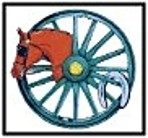2. Question:
Where can I buy a driving horse?
Answer:
Look in the local want adds in newspapers, at
feed stores and tack shops. Look for horses for sale at horseshows, playdays, and driving clubs. Look on the in a internet
for links on websites for horses for sale.
Always take a knowledgeable person with you to advise you, and LISTEN to him! Don't buy a horse because he looked
at you and whinnied, and you thought you and him "bonded".
Check our "Bulletin Board" and "Classified Ads."
4. Question:
Can retired track horses be trained to become a pleasure driving horses?
(Standardbreds)
Answer:
Yes. With a certain amount
of retraining and depending on how well they drove to start.
A great advantage with these horses is they
already are exposed to commotion, loud noise, crowds, other horses, trailering etc.
6. Question:
What do I need to do before driving my horse?
Answer:
The Begainner should take lessons from the most competent teacher he can find! A
self-taught person inevitably contracts bad habits which can be dangerous and very difficult to
break, even when he knows a better way. The longer he drives without competent criticism the more fixed
these bad habits will become. A pupil should make up his mind to do precisely what his instructor tells him.
Even well advanced persons still learn by attending clinics and watching another person drive. One never know it
all! There is always room for improvement. Keep an open mind, and accept criticism gracefully as they are only trying
to help you! There is always something to learn.
Driving can be very dangerous if proper training of the horse and person isn't done. A book or video is a great investment,
reinforced with a competant instructor, and will help keep you and your horse safe. It is your responsibility to inform yourself
on the basics of driving the horse in harness.
7. Question:
How can I avoid
accidents while driving?
Answer:
It is important that you always pay attention
to your surroundings at all time while you are driving your horse. Keep one eye on your horse, carriage, and harness and the
other eye out for dogs, traffic, and objects, and conditions that might scare your horse. Keep your vehicle and harness in
top condition always. Do not compromise your equipment. Be Prepared!
Never remove the bridle
or reins while the horse is hitched to the cart for any reason.
Never put your reins / lines down or tie them to the dash board while you
and passengers are still in the vehicle. Keep reins or Lines in hand at all times.
Never leave the vehicle while passengers are still in it. If the horses(s),
harness need attention ask someone to do it for you. If not possiable all passengers must get out of vehicle.
The driver must always get into the vehicle first, and is the last one out.
Improper harnessing, breeching not adjusted properly, wrap straps not properly adjusted or not on at all will cause
the cart to interfere with the horse, and can cause him to kick or run away, or worse cause an innocent bystander to be hurt
.
It is your responsibility to inform yourself on the basics of training, hitching, and driving the horse in
harness.
A few simple steadfast rules will make your driving experience a fun, pleasureable, and safe
experience.
Question:
What is the best way to make sure my horse is safe to drive on
or along a busy road?
Answer:
The best way is to accustom the horse to traffic before
he is put to a carriage. Put the horse in a pasture next to a road so he can see and hear traffic. Have someone sit in a stationary
vehicle and talk in a friendly manner, maybe feed him some treats and pet him. Introduce the horse to school buses,
large trucks, tractors, motorcycles, etc. Let him sniff and walk all around it if possible. If the horse can be ridden,
get him accustomed to traffic under saddle first. You can lead a horse or pony while riding another traffic safe horse who
will transmit confidence to the young horse.
Many road conditions can prove dangerous to a horse that is afraid of traffic. Ditches, uneven sholders, narrow roads
can cause the carriage to tip over if the horse whips around to avoid a car, truck, motorcycle or tractor.
For the first few outings on a road, if at all possible, choose one that is flat, has good shoulders, and light traffic. Make
sure you take a good assistant along who can easily dismount from the carriage and go to the horse's head.
Most importantly, your horse should have confidence in you as his leader. He should be trained to stand without moving
for an indefinite period of time at your command.
Question:
What is the differance between
"Lines" and "reins"?
When I say reins I am corrected to lines, and when I say lines, I am corrected to reins.???
Answer:
When one is driving a light horse(s),
Hitched to a carriage or light vehicle, they ane called reins. When driving a heavy, draft
horse, hitched to farm implements, they are called lines.

